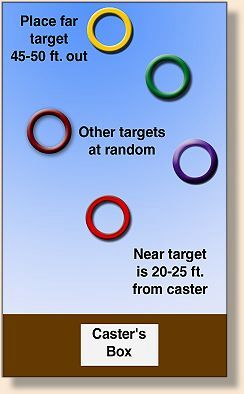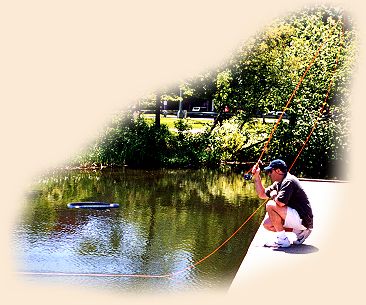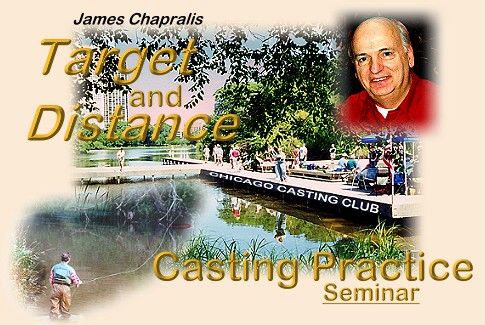|
In order to enjoy better fishing results, it is necessary
for most anglers to practice casting on a continuing basis. Admittedly,
practice is b-o-r-i-n-g, so it's my job to make casting practice so
much fun that you'll almost like it as much as fishing! And down the
road you might even want to enter a casting tournament! And Win!
LESSON FOUR: The Trout-Fly Event
To review: To succeed in fly fishing, we need to become
good casters primarily in terms of accuracy, but also, under
certain circumstances, in distance. In our introduction,
we mentioned that most of us learn the fundamentals of
casting through books or videos, casting schools, or,
perhaps, from a veteran fly-casting friend. But between
fishing trips, these lessons are lost, so it is necessary
to practice our casting periodically. We agreed that usually
practice isn't fun, but we're going to make casting practice
"fun," to a point that many of us will actually look forward to it.
Last week (Lesson Three): We discussed the Dry-Fly Event,
which is not only a springboard to successful trout fishing but
very helpful in just about every type of fly fishing where casting
accuracy is needed. Assuming that you've practiced the Dry-Fly
Event, let's move on to one of the most exciting casting challenges:
The Trout-Fly Accuracy Event. This is a crucial game because it
stresses three very important and different casts: the Dry-Fly,
the Wet-Fly and the Roll-Cast presentations.
PLACING THE TARGETS: The placement of targets is exactly the same
as for the Dry-Fly Event (Lesson Three), so you don't have to
change a thing. We'll include the same diagram of target placement
in this lesson for your immediate reference.
 THE TACKLE: You can use any fly-rod outfit you have, but let me
give you the optimum tackle for two reasons: (1) It's probably
the best outfit for 75 percent of the stream trout fishing you'll
encounter, and, (2) it will come close to what's called for in
casting tournaments (hey, some of you are going to enjoy this
so much and progress to a point where you may want to enter local,
regional or national casting tournaments).
THE TACKLE: You can use any fly-rod outfit you have, but let me
give you the optimum tackle for two reasons: (1) It's probably
the best outfit for 75 percent of the stream trout fishing you'll
encounter, and, (2) it will come close to what's called for in
casting tournaments (hey, some of you are going to enjoy this
so much and progress to a point where you may want to enter local,
regional or national casting tournaments).
The Rod: Do you have an 8½-foot fly rod that is
calibrated for a No. 6 tapered fly line? Great. Use it for this event.
If you don't have one, use a fly rod that's comes closest to it
in terms of length and line weight.
The Line: A No. 6 tapered floating line (for this
event a double-taper (DT6F) line is preferable to a forward-taper (WF6F) fly line).
The Reel: Your normal single-action fly reel is perfect.
The Leader: At least 9-ft. long (which is
standard for most trout fishing) tapered to about .008 (3X) or less.
The Fly: Use a practice fly (see Lesson Three)
but trim it so that the wound hackle is about a ½ inch in diameter.
Or, if you prefer, tie on a small piece of bright yarn to the tippet.
THE TROUT-FLY EVENT: As mentioned, there are three different casting
rounds in this event: Dry Fly, the Wet Fly and the Roll Cast. Let's
do them in the sequence:
THE DRY-FLY ROUND
Hold the practice fly in the non-casting hand with no
more than the leader plus two feet of line extending beyond
the rod tip. Now start false casting so that the line, leader
and fly are moving in the air, back and forth without
intentionally striking the surface in front of you. While
false casting, strip some fly line from your reel and let
it pass through the rod guides, until you think you have
enough line out to hit the first target. If you feel that
you have let out too much line to hit the near target, strip
in some line while false casting. After adjustments are made,
and your fly seems to hover over the target while false casting,
make the final forward cast or presentation and allow the fly
to settle on the target. That's it! Nice going.
Now you are ready for the second target. Lift the fly off the
ground or water and begin false casting again over the second
target. Adjust your line by stripping out more line from the
eel and letting it feed through the guides. If you let out too
much line, strip some in. When you think the fly will land in
the center of the target, make your presentation and drop the
fly into the target.
Now proceed to the third, fourth and fifth target. This completes
the Dry-Fly Round. If you miss the target by one foot or less
you have a demerit of one. If you miss by more than one foot,
the maximum demerits you receive are two. In the official
tournament rules there are other demerits (such as ticks,
improper strips, etc.), but right now we don't have to be
concerned with them. Keep track of your demerits and total
them for the Dry-Fly Round.
THE WET-FLY ROUND
Okay, now strip in the line (don't reel it in) and hold the
fly in your noncasting hand with no more than two feet of fly
line beyond the tip of the rod. Begin to false cast and let
out line through the guides until you feel that your fly is
over the near target. You can make as many false casts as you
like on the first target. When you're ready, make your
presentation.
Now lift the fly line make only one false cast in which you
allow enough line to slip through the guides to reach the
second target. After a single false cast you must make your
presentation.
Lift the line again, make one false cast and go to the third
target. Repeat the procedure and aim the fly to the fourth
and finally the fifth target. Remember: Only one false cast
is allowed between targets. Use the same demerit system that
you used for the Dry-Fly Round.
Keep track of your score for the Wet-Fly Round.
THE ROLL-CAST ROUND
After your final cast in the Wet-Fly Round you retrieve the line
by stripping it in until the fly is at the closest target. Now
you roll cast and try to hit the first target. After you hit it,
you go to the next nearest target, and when you hit that continue
to the third, fourth and fifth target in the same sequence as in
the two previous rounds. Simple? Right?
Well, almost. I forgot to tell you something. You have to hit
all five targets within a total of 15 roll casts. That's not
easy to do. You may need to brush up on roll casting (again
Wulff, Kreh, Krieger, and others have marvelous how-to-cast
books and videos). You get two demerits for each target you
do not hit. In other words, if you hit three targets within
the 15 allotted casts, you get four demerits (two demerits
for each of the two targets you didn't hit).
 Many anglers do not practice the roll cast. Dave
Madden has worked hard to perfect his roll cast. He is able to "shoot"
out his roll cast with power, distance and a narrow loop.
Many anglers do not practice the roll cast. Dave
Madden has worked hard to perfect his roll cast. He is able to "shoot"
out his roll cast with power, distance and a narrow loop.
Note: This round is best cast on water, but it can be done on
land (it's just harder to roll cast on ground because you don't
have the pull of the water on your line to help load the rod.
If you cast on ground you might increase the number of allotted
roll casts). The best way to lengthen the line from one target
to another is to wiggle the rod tip back and forth, allowing
loose line to pass through the guides.
YOUR SCORE: Add the demerits from the Dry-Fly, Wet-Fly
and Roll-Casting rounds. Subtract the total demerits from 100
and you have your score.

Important: Keep a simple scorecard so that
you can observe your progress.
It's important to keep track of your scores. As you improve your
casting skills, so will your scores, and this will motivate you
to practice more.
Here's my arbitrary score rating for the Trout-Fly Event.
We will not count ticks, improper strip demerits, etc.
Just accuracy demerits.
Under 70: Something is wrong somewhere. Your math?
My math? It's impossible to cast under 70, since we're not
counting ticks and other nonaccuracy demerits right now.
You can only get 10 demerits in each of the three rounds.
71 to 80: You're casting is a little rusty, but you'll
notice improvement very quickly as you continue to practice.
Keep it up!
81 to 85: You've got the basics down fairly well. You're
doing fine.
86 to 90: You're casting very well! Excellent casting mechanics.
Good eye-and-hand coordination.
91 to 95: Superb! What else can I say?
96 to 100 (Super Elite Class): You should enter the
ACA National Casting Tournament! You're among the top 1 percent
of fly casters in the world!
HOW DOES THE TROUT-FLY EVENT HELP OUR FISHING? Casting
accuracy is vital in nearly all fly fishing, but especially
fishing for trout and salmon.
Dry-Fly Round: We've covered the benefits of the Dry-Fly
segment in Lesson Three, so I won't repeat them here.
The Wet-Fly Round: You're fishing a streamer, nymph,
wet fly or even a dry. A trout rises to take a natural or you
see that flash underneath the surface. You need to deliver the
fly quickly and accurately. One false cast and deliver. In the
wet-fly event you learn to shoot line on the back cast or on
the forward cast.
In subsurface fishing you may want to cover a section systematically
by fan casting. Lift. One false cast. Deliver. Allow the fly to do
its thing and then lift, false cast (allow some line through the
guides) and deliver. Keep repeating this. Fan casting is a
basic fishing approach for Atlantic salmon but can be employed
with most river or stream fishing, especially when fishing wets
in discolored waters.

The Wet-Fly Event comes in handy for many stream applications.
This angler is fan casting on a salmon river, but you can use
the same approach on trout streams with wet flies and streamers.
The Roll-Cast Round: If you fish small, brushy streams, or
even big rivers where you can't make a back cast, the roll cast
is not only imperative, it is essential for fishing success.
You learn accuracy and how to lengthen your roll cast. Many
neophytes never practice roll casting, except when absolutely
necessary-while fishing! In all these rounds, you will learn
to judge the distance of the fly to the target while false casting.
HOW TO MAKE THIS MORE FUN: Again you should keep track
of your scores. By practicing often, you will notice improvement
on a continuing basis. Use my arbitrary scoring system presented
above and try to move from one level of skill to another. This
will fuel your enthusiasm for more practice. The Trout-Fly Event
teaches you three important types of casting. In fact, if you
learn these three casts well, your fishing results will zoom.
Guaranteed!
As per Lesson Three, get your friends, family, fishing club,
TU or other organizations to become involved in this wholesome,
worthwhile fun activity.
Learning the Trout-Fly Event is challenging. Practice it!
Don't give up easily. Suddenly it will come to you, and
your going to feel very good about your casting, and most
importantly, catch more and bigger fish. ~ Jim C. Chapralis
Next Week: The Bass-Bug Event (Okay, we've concentrated
on the trout fishers, so next week we'll learn a fascinating
game that will help you improve your results for bass and for
other species where you need to throw a larger fly, quickly,
accurately and farther).
About Jim:
Jim Chapralis is a world traveler, a pioneer in the international fishing
travel business, and author, most recently of Fishing Passion, reviewed in
our Book Review section. He is an avid angler - and caster.
Currently involved with the 94th Annual National Casting
Tournament July 29 to August 3, 2002. You can reach Jim via his
website www.AnglingMatters.com
|

 Many anglers do not practice the roll cast. Dave
Madden has worked hard to perfect his roll cast. He is able to "shoot"
out his roll cast with power, distance and a narrow loop.
Many anglers do not practice the roll cast. Dave
Madden has worked hard to perfect his roll cast. He is able to "shoot"
out his roll cast with power, distance and a narrow loop.


 THE TACKLE: You can use any fly-rod outfit you have, but let me
give you the optimum tackle for two reasons: (1) It's probably
the best outfit for 75 percent of the stream trout fishing you'll
encounter, and, (2) it will come close to what's called for in
casting tournaments (hey, some of you are going to enjoy this
so much and progress to a point where you may want to enter local,
regional or national casting tournaments).
THE TACKLE: You can use any fly-rod outfit you have, but let me
give you the optimum tackle for two reasons: (1) It's probably
the best outfit for 75 percent of the stream trout fishing you'll
encounter, and, (2) it will come close to what's called for in
casting tournaments (hey, some of you are going to enjoy this
so much and progress to a point where you may want to enter local,
regional or national casting tournaments).